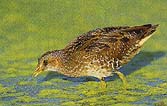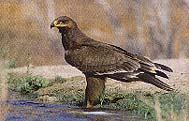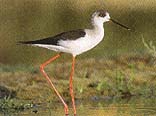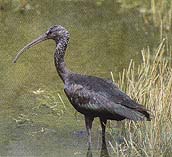Text and pictures by Hanne and Jens Eriksen
Is this place Arabia? Indeed it is and it is all man-made.
 Al Ansab Lagoons lie about 30kms west of Muscat, the capital of
the Sultanate of Oman. The lagoons were made about ten years ago
as a series of sewage settling ponds, but with the construction
of a large sewage treatment plant adjacent to the lagoons a few
years ago, only treated effluents are now fed into the ponds.
The water level fluctuates as the need for treated water for irrigationof
ornamental plants along the major highways variues during the
year. In summer hardly any water can be spared for the ponds and
water-level drops daramatically, exposing large muddy areas -
ideal for waders. During the winter months when less water is
needed for irrigation, the ponds fill up again.
Al Ansab Lagoons lie about 30kms west of Muscat, the capital of
the Sultanate of Oman. The lagoons were made about ten years ago
as a series of sewage settling ponds, but with the construction
of a large sewage treatment plant adjacent to the lagoons a few
years ago, only treated effluents are now fed into the ponds.
The water level fluctuates as the need for treated water for irrigationof
ornamental plants along the major highways variues during the
year. In summer hardly any water can be spared for the ponds and
water-level drops daramatically, exposing large muddy areas -
ideal for waders. During the winter months when less water is
needed for irrigation, the ponds fill up again.
The lagoons have turned into the most interesting site for birds in the capital area. To date almost 200 species of birds have been recorded here. A visit any time from september to May is likely to produce a list of over 50 species. Migration time is very exciting as almost anything can turn up. From early autumn waders from their high Arctic breeding grounds start to arrive. Little stint (Calidris minuta), Temminck's stint (C.temminckii), dunlin (C. alpina) and curlew sandpiper (C.ferruginea) are there in good numbers. The noisy wood - and green sandpipers (Tringa glareola and T.ochropus) are easy to find and even the two uncommon Tringa species, spotted redshank (T.erythropus) and marsh sandpiper (T.stagnatilis) usually put in an appearance.
Members of the crake family are usually very hard to see as they tend to hide in reedbeds and other dense vegetation during the day. At Al Ansab Lagoons, however, we have often seen spotted crake (Porzana porzana) and Baillon's crake (P.pusilla) completely out in the open in clear sunshine.
During the autumn months the number of black-necked grebes (Podiceps nigricollis) gradually increases at the lagoons until a maximum of 30 to 40 is reached in December. The fact that the numbers build up slowly indicate that these birds regularly migrate through the area. The grebes must just have continued unnoticed before the lagoons came into existence. Now the birds find the area to their liking and settle in for winter. Their cousin, the little grebe (Tachybaptus ruficollis) stay all year and a few pairs have nested in recent years.
 From November raptors of several species become more apparent. On hot days we have seen 25 to 30 steppe eagles (Aquila nipalensis) sitting next to each other drinking water from one of the ponds. In addition to steppe eagles, imperial (A.heliaca) and great spotted eagles (A.clanga) are commonly encountered. The whole area must be one of the best in the world for large birds of prey. More than once have we seen five species of eagles within half an hour.
From November raptors of several species become more apparent. On hot days we have seen 25 to 30 steppe eagles (Aquila nipalensis) sitting next to each other drinking water from one of the ponds. In addition to steppe eagles, imperial (A.heliaca) and great spotted eagles (A.clanga) are commonly encountered. The whole area must be one of the best in the world for large birds of prey. More than once have we seen five species of eagles within half an hour.
In mid-winter ducks are common. About ten species are usually seen with green-winged teal (Anas crecca) being the most numerous. Various species of herons frequent the ponds and even white spoonbill (Platalea leucorodia) and glossy ibis (Plegadis falcinellus) are regularly recorded.
During the spring months the number of birds gradually declines as they start to move north. Attention now turns to the breeding populations of black-winged stilts and red-wattled lapwings. It is amazing that the eggs and chicks can survve, as both species breed in the hottest time of the year: May and June. The first breeding record of black-winged stilts in Oman was here at Al Ansab lagoon in 1987, when three pairs successfully raised their young. Since then up to 15 pairs have nested there each season.
 On a recent late afternoon visit to the lagoons we decided to stay till late in order to witnmess the arrival of Lichtenstein's sandgrouse (Pterocles lichtensteini). These birds come to drink only when it is almost dark. Then they seem to drop straight out of the sky. Suddenly they are there. Half an hour earlier we had seen hundreds of pied wagtail (Motacilla alba) take off in groups of 20 to 50, presumably to head north towards their breeding grounds. Scores of barn swallows (Hirundo rustica) and sand martins (Riparia riparia) were replacing the wagtails. As we were driving away two nightjars (Caprimulgus europaeus) were caught in the car's headlights, while we were resting on the road. Such are the surprises of these fascinating lagoons.
On a recent late afternoon visit to the lagoons we decided to stay till late in order to witnmess the arrival of Lichtenstein's sandgrouse (Pterocles lichtensteini). These birds come to drink only when it is almost dark. Then they seem to drop straight out of the sky. Suddenly they are there. Half an hour earlier we had seen hundreds of pied wagtail (Motacilla alba) take off in groups of 20 to 50, presumably to head north towards their breeding grounds. Scores of barn swallows (Hirundo rustica) and sand martins (Riparia riparia) were replacing the wagtails. As we were driving away two nightjars (Caprimulgus europaeus) were caught in the car's headlights, while we were resting on the road. Such are the surprises of these fascinating lagoons.
 Although water in a desert country is in short supply we can only hope that some can be spared to keep Al Ansab Lagoons alive in future. A great number of birds depend on this area and there is nowhere else to go. For now, however, the area is blessed by a rich avifauna. Many visitors have been de-lighted and surprised to see so many birds, and students from Sultan Qaboos Univer-sity use the area as an outdoor laboratory. In addition to birds the area is well endowed with plant and insect life. We've even seen the shy Arabian gazelle (Gazella gazella) come down to drink at midday.
Although water in a desert country is in short supply we can only hope that some can be spared to keep Al Ansab Lagoons alive in future. A great number of birds depend on this area and there is nowhere else to go. For now, however, the area is blessed by a rich avifauna. Many visitors have been de-lighted and surprised to see so many birds, and students from Sultan Qaboos Univer-sity use the area as an outdoor laboratory. In addition to birds the area is well endowed with plant and insect life. We've even seen the shy Arabian gazelle (Gazella gazella) come down to drink at midday.
Arabian Wildlife. Volume 1, Number 2